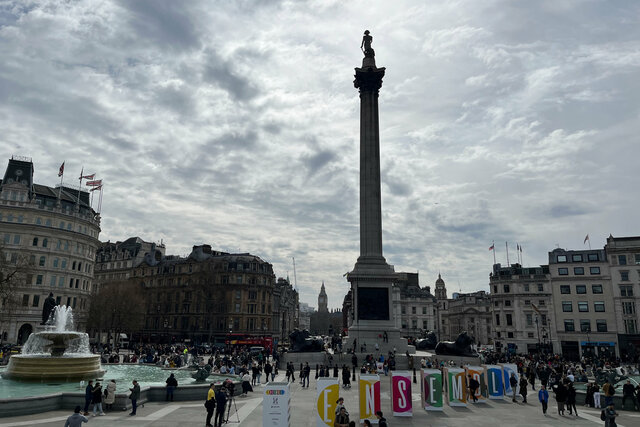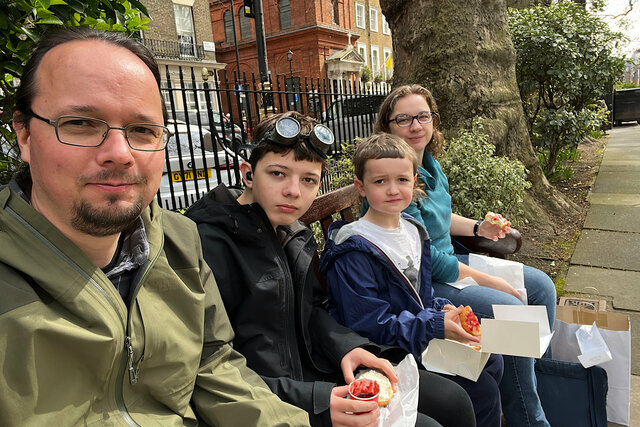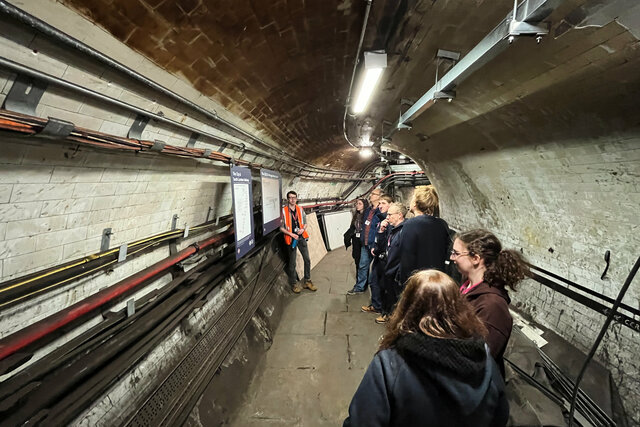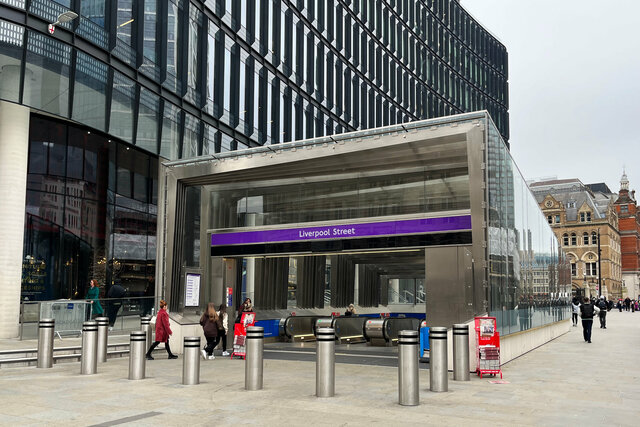Metropolitan Maze
Started: 2023-04-16 11:25:17
Submitted: 2023-04-16 16:21:25
Visibility: World-readable
Parliament and Monument and Moorgate and Dishoom
On Wednesday, the 5th of April, we had timed tickets for a multimedia tour of the Palace of Westminster at 10:00. Our ticket indicated that we should arrive at the visitor's entrance, on Cromwell Green twenty minutes before our timed ticket to go through security. After breakfast we took the sub-surface District Line east to Westminster, then ascended to ground level through the network of columns and beams built through the station serving as the foundation of the building above. The streets outside the station were somewhat less crowded than the previous afternoon as we made our way past Parliament Square.
After security (and signs explaining the sort of "offensive weapons" banned in the UK, including knives with blades longer than three inches, which I interpreted as "please don't make us arrest you over something that might be legal where you come from") we walked out of the security tent around the corner of the building to a stunning unobstructed view of the clocktower informally known as "Big Ben", marking the northern edge of the elaborate neo-gothic Houses of Parliament.
We collected our audio guides in Westminster Hall, one of only two rooms where photography was allowed, so I stopped to take pictures of the other tourists looking around the massive drafty historic hall built in 1097. It's hard to see in the picture but the ceiling was built out of huge wooden beams arched high above us. This hall was one of the oldest rooms on the site (most of the rest of building was rebuilt after a devastating fire in the nineteenth century). This hall has been used for many important state events, many of which were marked by plaques on the floor — most recently as the public viewing site for Queen Elizabeth II lying in state last September. (There was no plaque yet for that particular event, and the audio guide seemed to have been recorded around 2017 so it still referred to Queen Elizabeth II as the current monarch.)
The tour took us up the steps at the far side of the hall into St. Stephen's Hall, rebuilt after the nineteenth-century fire on its original site. The hall was lined with statues of ministers and other historic figures, with large paintings on both sides of the hall depicting historic battles and other events in English history. The neo-gothic decorative elements in the hall featured the motifs I saw throughout the building: the symbol of the rose (representing the monarchy) and the portcullis (representing Parliament) repeated on opposite sides of almost every doorway and window.
We followed the tour into a central hallway used by both visitors and members of Parliament and their guests, then turned right towards the House of Lords. The audio guide pointed out that the cushions on the benches on the hallway leading to the House of Lords were colored red, representing the color of the assembly. We walked through a large reception room with a huge mural of the Battle of Waterloo, then turned off into the entry used by the monarch to visit Parliament during the state opening. At length we looped into the House of Lords itself, which was barely large enough to hold enough benches for all of the members. The chamber was elaborately decorated, especially the throne used by the monarch to address the assembly during the state opening.
We left the Lords and headed to Commons, where the dominant color of the bench cushions (both in the hallways and in the house itself) switched to a deep green. In the lobby outside the house were letterboxes for all of the MPs; I spotted slots for Liz Truss and Jeremy Corbyn in the huge banks of names I mostly didn't recognize. We walked through the No Corridor (where members walk to vote no) and it appeared from the badge-readers and tablets on stands through the corridor that the members vote using their security badges, which was an interesting modern touch I wasn't expecting.
Then we stepped into the tiny House of Commons itself. It was hard to imagine hundreds of Members of Parliament crammed into the benches lining both sides of the chamber, facing each other across a narrow space in the middle of the chamber. Instead we had a guide talking to an organized tour group on one side of the chamber, and several smaller groups listening to their own audio tours on the other side of the chamber.
We departed the House of Commons and headed back out through St. Stephen's Hall and Westminster Hall. We exited via the gift shop, then left Parliament to step back out onto the pavement outside the perimeter fence.
We walked up Whitehall towards Trafalgar Square; I played tour guide and pointed out the Cenotaph and Number 10 Downing Street as we walked. In Trafalgar Square, I took Julian around the square hunting down items from his scavenger hunt book Mission: London while Kiesa placed an order for lunch.
The scavenger hunt included taking a picture of Julian with the lions surrounding Nelson's Column. There were lines to stand right in front of each lion (some people were climbing up on the lions themselves), but Julian decided he would be happy to get a picture next to the lion, skipping the wait.
The fourth plinth, home to a rotating series of public art, held a statue titled Antelope, recreating a 1914 photograph showing an African Baptist preacher defying colonial rule by wearing a hat in front of a white person.
The scavenger hunt pointed out one thing I hadn't seen in Trafalgar Square: markings depicting the imperial standards of length, embedded in the wall, mostly ignored by the people sitting around it eating lunch and otherwise enjoying one of London's greatest public squares.
With our scavenger hunt completed, we headed north out of Trafalgar Square, around the side of the National Gallery, past Leicester Square, and into Soho. (Looking at this walk on the map, the route is bisected by several deep-level tube lines, so it seems like it ought to be further, but it was only a ten-minute walk.)
While we were walking around London I was often in the lead, because I had the plan and knew where we were going, often augmented by a quick consultation of my map on my phone. But this meant I couldn't see the rest of my family to know whether they were following me, or if they had gotten stuck behind someone or something, or interested in something else on the street. In the sci-fi novel A Desolation Called Peace, Arkady Martine describes fighter pilots whose sense of proprioception is augmented so that they can sense the presence of their squad in space around them. I wanted that upgrade for myself.
Kiesa nipped into Gail's Bakery Soho to pick up her take-away order, then we walked a couple of blocks to Soho Square Gardens to look for a place to eat. Kiesa spotted a bench on the far side of the park that opened up just as we needed it.
This time we got scones for each of us, plus clotted cream and jam. We also got four sealed retail jam jars, apparently because Kiesa hit the wrong button. We did not have any utensils, but we managed to serve the scones from the park bench without making too much of a mess.
After our scone-lunch we split into two groups. Calvin and I headed to a Hidden London tour of Moorgate Station, which advised us that kids were limited to those fourteen years and older. Calvin turned fourteen the previous week, so he just skated by. Kiesa took Julian to a playground somewhere out on the Bakerloo Line, and we resolved to meet for supper.
Calvin and I walked a few blocks east to Tottenham Court Road and rode the Central Line east to Bank. (In Bank station I pointed out the large horizontal gap between the train and the platform, because the station was built on a large curve in the line and it's impossible to get a train carriage on a curved track to line up to a platform. Bank was a particularly egregious example; I stepped over a nine-inch horizontal gap to get to the platform.) We were early to visit The Monument to the Great Fire of London, so we stepped out onto London Bridge to look down the Thames, then returned to The Monument to join the queue of people just as it reopened at 14:00 after lunch. (There are many monuments in London; but there is only one The Monument.)
The queue moved fast enough, and soon we entered the door at the base, paid admission, and began climbing the 311 steps up the helical staircase to the observation deck at the top.
We reached the observation deck before any of the people in front of us in the queue had started to descend the tower, so the narrow platform, barely two feet deep in places between the stone walls of the tower and the the vertiginous drop on the other side of the open steel railing, was packed with people. At least there was a steel mesh completely enclosing the deck, from the bottom of the platform all the way to the top of the the tower, so there was no physical way one could actually fall off the platform, or even drop anything larger than a pencil through the mesh.
We made our way around the tiny observation platform and saw the weird and wonderful skyscrapers in the City of London just north of The Monument. My camera wanted to focus on the steel mesh right in front of my face rather than the buildings beyond, so I had to put it into manual focus and hope for the best. (The first time I visited London with Kiesa, the Swiss Re building was the newest and weirdest building on the City of London's skyline, but now it's been completely eclipsed by newer weirder buildings.)
After orbiting the observation deck we descended the helical staircase back to the bottom of the tower. This time we encountered people going in the opposite direction, so we had to awkwardly pass on the tiny steps. At the bottom of the tower we received certificates with a blank spot for our names at the top confirming that we had climbed the tower. I found a bench to sit on to catch my breath from climbing the tower before we continued to our next stop.
Our next stop was the Hidden London tour at Moorgate Station. We rode the Northern line (Bank branch) one stop north to Moorgate, then tried to figure out where to meet for the tour. We were early, so when I found a sign on the wall on the concourse level saying the tour was meeting there we camped out there. No one had shown up by the time we were supposed to meet (but there were some other people hanging out nearby who looked like they might be waiting for the tour) so I went on a quest to find other possible meeting places, none of which looked quite right. Eventually a small group of people in high-vis jackets with the London Transport Museum logo showed up and they led us back downstairs to the meeting point by the sign and checked us in for the tour.
Moorgate Station is a composite station built from three separate lines, each with their own set of platforms: the sub-surface Metropolitan line; the Northern line (the first deep-level tube tunneled through the clay below London); and terminating National Rail suburban service, dug using large tunnels under the streets. The tour highlighted the unused spaces throughout the station, as the station grew and changed over the 150 years it's been in operation.
We started the tour when the station agent let us into the fare gates, then we descended the public stairs half-way down to the deep-level Northern line (Bank branch) platforms. We stopped on a landing where the tour guides pulled out a bundle of keys and unlocked a door tucked onto the side of the wall, then stepped into a human-scale tunnel on the other side, once intended for pedestrian traffic leading to the underground platforms, but now replaced by more-modern escalators. The walls still bore the ceramic subway tiles that they had originally been decorated with, but the tiles were covered in grime and the walls were now used to carry electrical cables.
At the end of the winding corridor we stepped into the bottom of a disused lift shaft, which had originally been used to carry passengers up and down between the street and the platforms. On the far side of the platform was another corridor leading passengers in the opposite direction, creating a network of one-way tunnels underground to improve passenger flow. (The one-way tunnels solved one of the problems I experienced on the tube and on the pavements: which side of the walkway should I walk on? Sometimes signs encouraged walking on the right or the left, but often people walked on whichever side they felt like, oblivious to the idea that, if only we could agree which side to walk on, everything would be so much easier.)
We left the lift shaft and went around the corner to climb a stairway to nowhere. This stairway was lit only by a single bulb at the bottom, plus the guide's flashlight at the top. It was hot and stuffy, and the top end had been blocked off at least by the second world war; but once it had been intended for passengers, and the original subway tiles were still visible on the gracefully-curving ceiling, covered in the cement that had been used to glue the tiles to the wall, now leaking out and flaking away.
We returned to the public stairway and climbed back to the paid concourse level, then headed towards the subsurface platforms but turned into another unassuming unlabeled locked door at the bottom of a stairway. This led into another human-scale tunnel except that the entire tunnel had been repurposed for ventilation with a massive fan in the middle, with barely enough space to squeeze by on the sides. The fan itself was disused, but it occasionally moved slightly as its blades caught the subterranean breeze.
The tunnel showed a palimpsest of prior uses: it was built to move passengers between the Northern line and the subsurface lines, so its original subway tile still lined the walls; then it had been closed to passengers and repurposed as a ventilation tunnel. For that use the original floor had been removed and the ground had been lowered by less than a foot, apparently enough to provide a bit more air flow, exposing the spines of the cast iron tunnel segments. Now the tunnel was lined with utilities running along both walls, and smaller, foot-diameter ventilation ducts running along the opposite side.
We split into smaller groups to proceed down the tunnel to the highlight of the tour: an original Greathead shield, still in place at the end of the tunnels, the relic of a plan to extend the tunnels further south that never materialized. When our turn came we walked down the tunnels and ended up at the edge of the active tracks, just beyond the fence separating us from the paid area of the station, barely ten meters from the active train platforms and the driving cab of a suburban EMU sitting on the platform, waiting to take commuters north out of the city.
These tunnels had been dug with a large 16-foot diameter, capable of carrying mainline-sized trains, much larger than the 12-foot diameter tunnels of the deep-level tube lines. We walked along the side of the tunnel, next to the buffers at the end of the track, onto a walkway suspended above the floor giving us a view of the end of the tunnel, beyond a bank of more-modern electrical equipment. The shield is visible in the picture below, at the face of the tunnel: the ring with two vertical bars separating the digging sections. This was the state-of-the-art tunneling technology that allowed all of London's deep-level stations to be built, and here it was, sitting in plain view at the end of the tunnel.
We headed back up to the public area of the station, then walked past the current subsurface line platforms to the end of platforms 5 and 6 to look into the City Widened Lines. These lines were capable of carrying mainline-sized trains, and had been used to terminate Thameslink trains until the platforms at Farringdon were lengthened, cutting off access to the lines.
I gazed off the end of the fence separating me from the disused cavern stretching off into the distance, waiting quietly in the dark until the space can be put to use again.
We finished our tour at the new entrance built by Crossrail for the Elizabeth Line. The line doesn't officially stop at Moorgate, but the platforms for the next station stop at Liverpool Street stretch all the way to this station, so this station functions as a bonus entrance.
After the tour I found a bench to sit on while I considered our next move. It was late in the afternoon (after 16:00) and we didn't really have enough time to do anything else, but it was a little early to head to supper. My map indicated a monument to the Moorgate station disaster (a tube train overrunning the buffers at the end of the platform and hitting the wall beyond), but it looked like the monument was covered in construction scaffolding. We walked through a park to the east and ended up at Liverpool Street station to ride the Elizabeth Line west across the city to Paddington, then transferred to the subsurface lines to Kensington High Street.
We met Kiesa and Julian at the station, then headed out in the increasing rain to Dishoom just around the corner from the station. We arrived before 17:30 but there was already a queue out the door. (On an earlier visit to London, one of my colleagues told me that "the queue is part of the experience" at Dishoom.) Eventually we got in the door to the indoor waiting area, where we started with drinks; then we got a table and we studied the menu while I took notes on my phone on what we wanted to eat. Our final order was:
- Pau baji
- Paneer roll
- 2x gunpowder potatoes
- Black daal
- Jackfruit biryani
- Chilli butter-bhutta
- Tandoori roti
- Raita
- Chaap pineapple tikka
Our food came slowly at first, then all at once; and we began eating. Everything was different and delicious. Julian was the least adventurous; he tried to eat the corn on the cob but didn't like the chili powder, so he ate mostly rice. I liked the black daal and the gunpowder potatoes but everything was delightful in its own way.
When we finished eating we got the dessert menu and ended up with chocolate pudding. We headed back to our flat on the Circle line to retire for the night.
I took even more pictures than I included above; they're all at Photos on 2023-04-05.
























